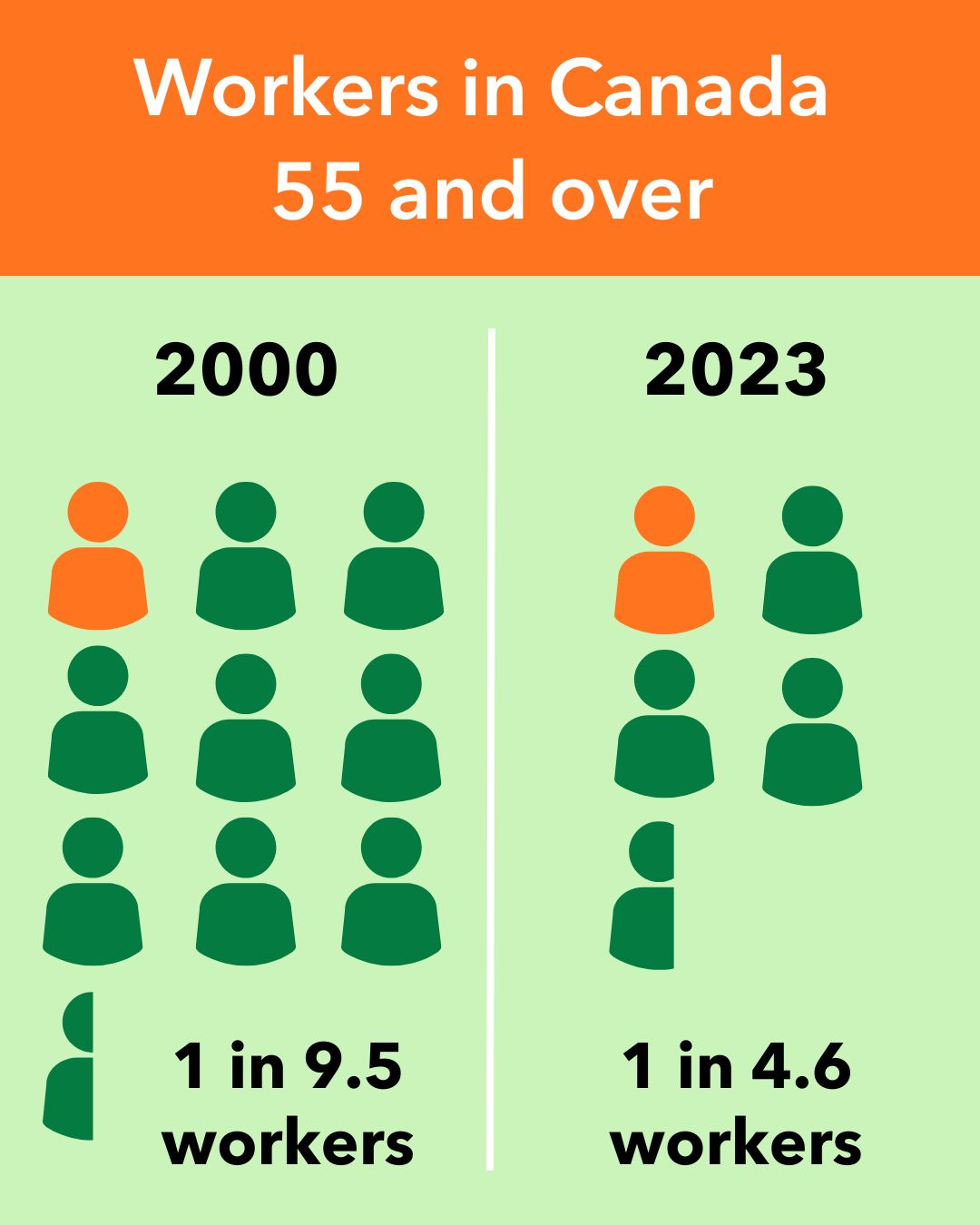Mature workers can boost productivity
Mature workers can boost productivity
Investing in workers over 55 offers multiple benefits for organizations.
For the French version of this post, please click here. | Pour la version française de cet article, veuillez cliquer ici.
From 2000 to 2023, the number of mature workers in Canadian workplaces increased by 184%. During that time, the proportion of workers 55 and over went from one in 9.5 workers to one in 4.6 workers.¹
This increase in older workers is due to multiple factors: the larger baby boomer generation, higher life expectancy, longer careers, declining birth rates, longer periods of education and later entry into the labour market, and financial need with the increasingly high cost of living.¹
Occupations at risk of labour and skills shortages
Some occupations have higher levels of mature workers, including sales and service (20% are mature workers), business, finance, and administration (17.7%), and trades and transportation (17%).¹ However, not all these occupations are at risk of a labour or skills shortage as workers retire.
Replacement ratios assess the risk of labour and skills shortages if many people retire at the same time. Based on replacement ratios, the occupations in Canada most at risk of shortages include management, manufacturing and utilities, and trades and transportation.¹

Workplace ageism common
Older workers can face barriers in the workplace, with ageism being the most common. A 2022 Seniors Forum by Employment and Social Development Canada found that almost 40% of respondents had experienced ageism in the workplace and almost 50% were concerned about discrimination during hiring.²
Participants reported that it was common for employers, managers, and co-workers to believe stereotypes about older workers. Stereotypes included being less capable, less productive, unable to use technology or to easily learn new skills, or to be in poor health.²
They made assumptions that older workers would not stay with a company for long, that they would retire by age 65, or that they were taking jobs away from younger workers.²
Benefits of mature workers
Mature workers offer many benefits to organizations, for instance they tend to remain with employers for longer periods, reducing hiring and training costs. They can have a strong work ethic, work well in team settings, and require minimal supervision, increasing productivity.³
Many workplaces work to retain mature workers due to their knowledge, skills, extensive experience and networks, and specialized expertise. Workers can pass this knowledge and experience on to new and younger workers by working together or through mentoring.³
Mixed-age teams, in addition to offering diverse insights, can significantly increase the productivity of both older and younger employees.4
Reluctance to communicate
Many older workers are reluctant to share information regarding personal or family health, training, or support needs with their co-workers or managers. They may only share the minimum required to obtain the support needed to do their job.5
In Canada, almost 28% of persons 45 to 64 years of age experience disability, increasing to 35% for people 65 to 75 years.6 Some older workers have caregiving responsibilities for family members with a health condition. Others have training-related needs that would help them with their job or career.5
Many mature workers fear that disclosure of age-related changes and mental health challenges may lead to ageism-related stigma. They may hesitate to discuss training and skills development if they feel others will judge their lack of knowledge or question the value of training older workers.6
Communicating support needs might affect their hard-won reputation as a productive, skilled worker and make them vulnerable to misperceptions about their abilities. They may fear being passed over for promotions or worry about job security.6

Credit: Wright Building Center via Unsplash.
Workplace accessibility and inclusion for mature workers
Organizations can take a proactive approach by creating an accessible and inclusive workplace with practices and policies that benefit all staff, including mature workers.
Build trust in the workplace
The ability to trust that your managers and co-workers will be supportive of your needs without judgement is fundamental to a safe workplace for mature workers.
- Provide training to leadership and staff around the importance and impact of accessibility, inclusion, and equity for workers experiencing disability and who have intersecting identities, such as mature workers.
- Consult workers through anonymous surveys about workplace needs and supports. Follow up by adjusting or developing policies and practices and reviewing them with workers.
- Have regular conversations with every staff member about what they need to do their job and to answer questions about your workplace’s accessibility, training, and professional development.
- Instead of asking mature workers about retirement, ask all workers open-ended questions about their career goals and where they see themselves in five years.
- Address discrimination and ageism immediately.
Offer options to manage needs without disclosure
Implement policies that give greater control to workers to manage needs without disclosure.
- Offer flexible work hours and the option to work from home, which can be helpful for workers experiencing disability or with caregiving responsibilities.
- Provide wellness days and paid personal days that can help manage health and reduce stress and burnout.
Provide opportunities for mixed teams and mentoring
- Create diverse teams that include people of various ages and backgrounds. Diverse teams often offer more innovative insights and solutions.
- Provide experienced workers with opportunities to mentor other workers of all ages. Mentorship can be through a formal workplace program or an informal work relationship.
- Team mature workers with younger workers on specific tasks to encourage knowledge transfer.
Research found that older workers who used a range of workplace policies and formal and informal supports as needed, rather than just when crisis occurred, reported fewer job disruptions and greater productivity.6
Open communication, mentoring, and knowledge transfer boost confidence and workplace satisfaction and enhance well-being and a sense of belonging. All are benefits to mature workers and to the organizations who invest in retaining them.
References
1. LMIC. Labour market resilience in the face of an aging population. August 2024. Accessed October 7, 2025.
2. Employment and Social Development Canada. Consultations on the social and economic impacts of ageism in Canada: “What we heard” report. 2022. Accessed October 7, 2025.
3. Employment and Social Development Canada. Age-friendly workplaces: Promoting older worker participation. August 27, 2024. Accessed October 7, 2025.
4. Göbel, Christian, and Thomas Zwick. Are personnel measures effective in increasing productivity of old workers? Labour Economics. Volume 22. June 2013.
5. Gignac MA, Bowring J, Shahidi FV, Kristman VL, Cameron JI, and Jetha A. Workplace disclosure decisions of older workers wanting to remain employed: a qualitative study of factors considered when contemplating revealing or concealing support needs. Work, Aging and Retirement. Vol 10 Issue 2. January 1, 2024.
6. Statistics Canada. A demographic, employment and income profile of persons with disabilities aged 15 years and over in Canada, 2022. May 28, 2024. Accessed October 8, 2025.
7. Employment and Social Development Canada. Promoting the labour force participation of older Canadians. August 27, 2024. Accessed October 3, 2025.

